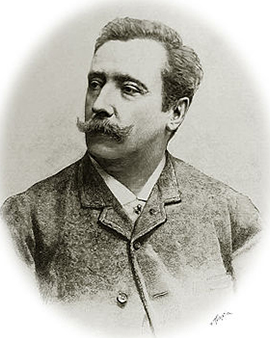


In the artistically vibrant halls of 19th century France, it was hard to find anyone with as fine a stroke as Émile-Antoine Bayard. Born in La Ferté-sous-Jouarre, Seine-et-Marne, in 1837, Bayard discovered the hidden secrets of art under the skillful guidance of his mentor Léon Cogniet. His remarkable talent allowed him to publish his first cartoons at only 15 years old, often under the creative pseudonym Abel De Miray. He artfully explored media such as charcoal drawings, paintings, watercolors, woodcuts and engravings. However, it was the exquisite "art print" technique of lithography that allowed his works to shine with a splendor never before seen.
The late 19th century was an era of change. The emerging photography pushed documentary drawing into the background. But Bayard, steadfast in his artistic vision, turned to new horizons. He illustrated literary masterpieces from Victor Hugo's "Les Misérables" to Harriet Beecher Stowe's "Uncle Tom's Cabin" to Jules Verne's visionary "From the Earth to the Moon." His portrait of the incomparable Cosette from "Les Misérables" later became iconic, adapted for the logo of Cameron Mackintosh's world-famous musical. This art print is a coveted rarity today and a living testament to his immense talent.
But it was not only literary illustrations that enchanted Bayard. Before man set foot on the moon, the infinite expanses of space already captivated him. While artists before him mystically transfigured space travel and alien worlds, Bayard sought the truth. His groundbreaking illustrations for Jules Verne's "From the Earth to the Moon" are among the first scientifically based depictions of outer space. They ushered in a new era of space art in which science and art merged harmoniously.
When Émile-Antoine Bayard breathed his last in Cairo in 1891, he left behind not only an impressive artistic legacy, but also the indelible memory of an artist whose visions lived long after his death. A master whose works are still reproduced today in art prints of the highest quality to inspire generations of art lovers.

In the artistically vibrant halls of 19th century France, it was hard to find anyone with as fine a stroke as Émile-Antoine Bayard. Born in La Ferté-sous-Jouarre, Seine-et-Marne, in 1837, Bayard discovered the hidden secrets of art under the skillful guidance of his mentor Léon Cogniet. His remarkable talent allowed him to publish his first cartoons at only 15 years old, often under the creative pseudonym Abel De Miray. He artfully explored media such as charcoal drawings, paintings, watercolors, woodcuts and engravings. However, it was the exquisite "art print" technique of lithography that allowed his works to shine with a splendor never before seen.
The late 19th century was an era of change. The emerging photography pushed documentary drawing into the background. But Bayard, steadfast in his artistic vision, turned to new horizons. He illustrated literary masterpieces from Victor Hugo's "Les Misérables" to Harriet Beecher Stowe's "Uncle Tom's Cabin" to Jules Verne's visionary "From the Earth to the Moon." His portrait of the incomparable Cosette from "Les Misérables" later became iconic, adapted for the logo of Cameron Mackintosh's world-famous musical. This art print is a coveted rarity today and a living testament to his immense talent.
But it was not only literary illustrations that enchanted Bayard. Before man set foot on the moon, the infinite expanses of space already captivated him. While artists before him mystically transfigured space travel and alien worlds, Bayard sought the truth. His groundbreaking illustrations for Jules Verne's "From the Earth to the Moon" are among the first scientifically based depictions of outer space. They ushered in a new era of space art in which science and art merged harmoniously.
When Émile-Antoine Bayard breathed his last in Cairo in 1891, he left behind not only an impressive artistic legacy, but also the indelible memory of an artist whose visions lived long after his death. A master whose works are still reproduced today in art prints of the highest quality to inspire generations of art lovers.
Page 1 / 4






